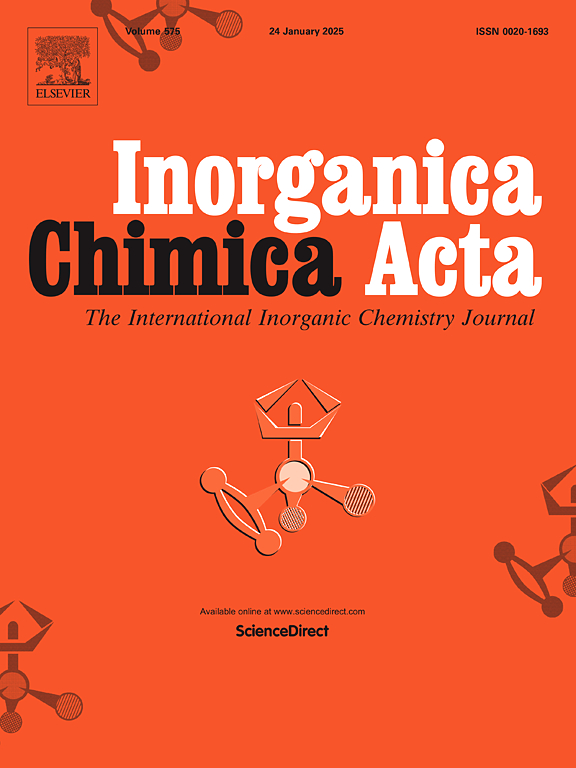红色铕配合物:合成、光物理和光电子性质
IF 3.2
3区 化学
Q2 CHEMISTRY, INORGANIC & NUCLEAR
引用次数: 0
摘要
本文合成了四种三元EuIII配合物[Eu(bfa)3(L)x] {L =二苯基亚砜(dpso) (1), dpsoCl(双(4-氯苯基)亚砜)(3)和tppo(三苯基氧化膦)(x = 2)(4)和dpsoCH3(4,4′-二甲基二苯基亚砜)(x = 3) (2)}, bfa = 4,4,4-三氟-1-苯基-1,3-丁二酮)},并对其进行了表征。配合物的结构经FTIR、13C和1H NMR分析证实。Sparkle模型/PM7分析表明,该配合物具有1 -和4 -双增广三角棱镜、3 -方形反棱镜和2 -球面顶盖方形反棱镜的结构几何形状。该配合物呈现红色发光,光致发光量子产率为32% ~ 61%。配合物中共配体的存在显著增加了光物理参数,特别是在固体状态下。测定了配合物的能量转移速率和反能量转移速率。该配合物显示出纯红光,CIE色坐标分别为x = 0.66和y = 0.33 (612 nm),表明它们可能作为有机发光器件(oled)的红色成分。其中配合物4表现出最高的效率和稳定性。结果,该复合物作为发射元件在具有多层结构的有机发光二极管中进行了测试。本文章由计算机程序翻译,如有差异,请以英文原文为准。

Red EuropiumIII complexes: Synthesis, photophysics and optoelectronics properties
In this article, four EuIII complexes of ternary nature, [Eu(bfa)3(L)x] {L = diphenyl sulphoxide (dpso) (1), dpsoCl (bis(4-chlorophenyl) sulphoxide) (3) and tppo (triphenylphosphine oxide) (x = 2) (4), and dpsoCH3 (4,4′-dimethyldiphenylsulfoxide) (x = 3) (2)}, bfa = 4,4,4-Trifluoro-1-phenyl-1,3-butanedione}, were synthesised and thoroughly characterized. The structures of the complexes were confirmed by FTIR, 13C and 1H NMR analyses. The Sparkle model/PM7 analysis shows that the complexes possess structural geometries as: 1 and 4 – Biaugmented trigonal prism, 3 –square antiprism, and 2 –spherical capped square antiprism. The complexes exhibit red luminescence with a photoluminescence quantum yields ranging from 32 to 61 %. The presence of co-ligands in the complexes significantly increases the photophysical parameters, particularly in the solid state. The energy transfer rates and back energy transfer rates of the complexes are determined. The complexes showed pure red emissions with CIE color coordinates as x = 0.66 and y = 0.33 (612 nm), suggesting their possible use as red component in organic light emitting devices (OLEDs). In particular, complex 4 exhibits the highest efficiency and stability. As a result, this complex– as an emiiting component– was tested in an OLED with a multiple layer structure.
求助全文
通过发布文献求助,成功后即可免费获取论文全文。
去求助
来源期刊

Inorganica Chimica Acta
化学-无机化学与核化学
CiteScore
6.00
自引率
3.60%
发文量
440
审稿时长
35 days
期刊介绍:
Inorganica Chimica Acta is an established international forum for all aspects of advanced Inorganic Chemistry. Original papers of high scientific level and interest are published in the form of Articles and Reviews.
Topics covered include:
• chemistry of the main group elements and the d- and f-block metals, including the synthesis, characterization and reactivity of coordination, organometallic, biomimetic, supramolecular coordination compounds, including associated computational studies;
• synthesis, physico-chemical properties, applications of molecule-based nano-scaled clusters and nanomaterials designed using the principles of coordination chemistry, as well as coordination polymers (CPs), metal-organic frameworks (MOFs), metal-organic polyhedra (MPOs);
• reaction mechanisms and physico-chemical investigations computational studies of metalloenzymes and their models;
• applications of inorganic compounds, metallodrugs and molecule-based materials.
Papers composed primarily of structural reports will typically not be considered for publication.
 求助内容:
求助内容: 应助结果提醒方式:
应助结果提醒方式:


